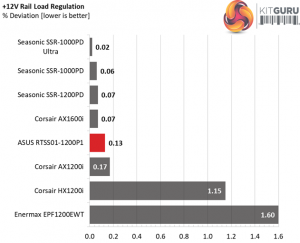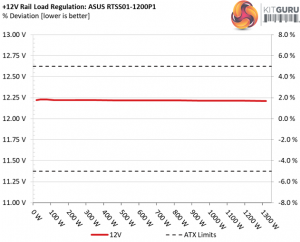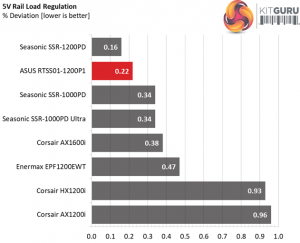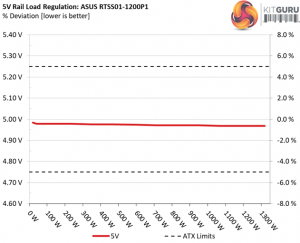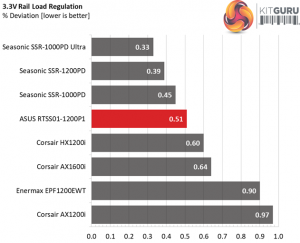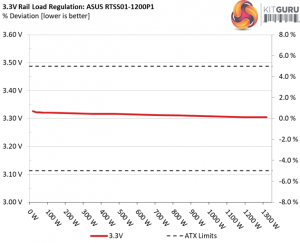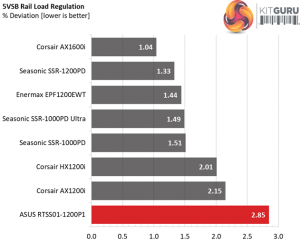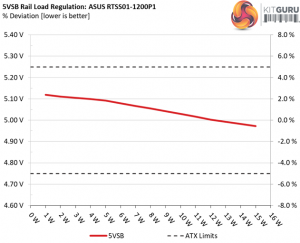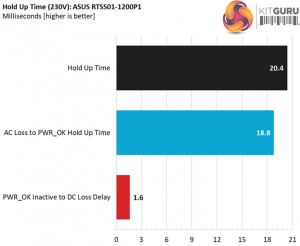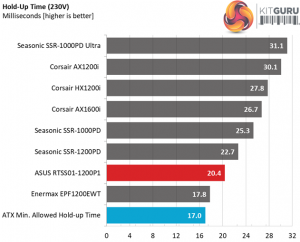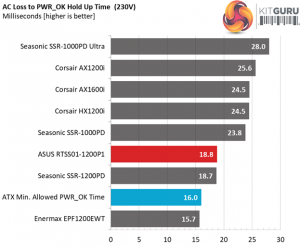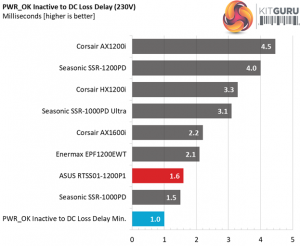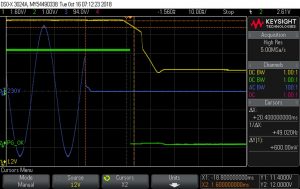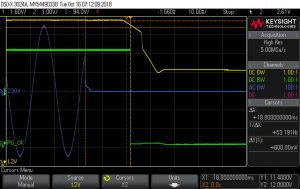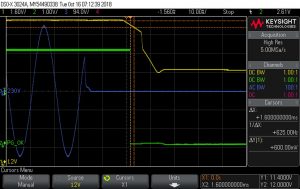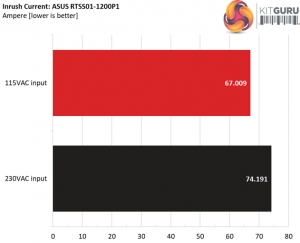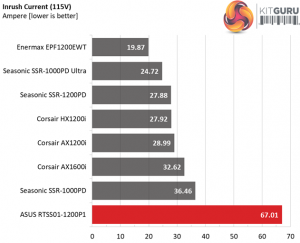To learn more about our PSU tests and methodology, please check out How We Test Power Supply Units.
Primary Rails And 5VSB Load Regulation
Load Regulation testing is detailed here.
Hold-Up Time
Our hold-up time tests are described in detail here.
The oscilloscope screenshots that we took during the hold-up time measurements:
The hold-up time is long and the power ok signal is accurate.
Inrush Current
For details on our inrush current testing, please click here.
The inrush current with both 230V and 115V is higher than the competition.
Load Regulation And Efficiency Measurements
The first set of tests reveals the stability of the voltage rails and the unit’s efficiency. The applied load equals (approximately) 10 to 110 percent of the power supplies maximum load in increments of 10 percentage points.
We conducted two additional tests.
During the first, we stressed the two minor rails (5V and 3.3V) with a high load, while the load at +12V was only 0.1A. This test reveals whether a power supply is compatible with Intel’s C6/C7 sleep states or not. In the second test, we determined the maximum load the +12V rail could handle with minimal load on the minor rails.
| Test # | 12V | 5V | 3.3V | 5VSB | DC/AC (Watts) | Efficiency | Fan Speed (RPM) | PSU Noise (dB[A]) | Temps (In/Out) | PF/AC Volts |
| 1 | 8.056A | 2.008A | 1.985A | 0.982A | 120.059 | 85.305% | 570 | 11.2 | 40.14°C | 0.960 |
| 12.223V | 4.979V | 3.321V | 5.092V | 140.741 (*143) | 44.56°C | 115.05V | ||||
| 2 | 17.091A | 3.012A | 2.982A | 1.181A | 239.741 | 89.842% | 572 | 11.3 | 40.61°C | 0.977 |
| 12.220V | 4.978V | 3.319V | 5.079V | 266.848 (*264) | 45.62°C | 115.05V | ||||
| 3 | 26.451A | 3.520A | 3.466A | 1.382A | 359.246 | 91.254% | 576 | 11.5 | 41.23°C | 0.985 |
| 12.220V | 4.976V | 3.317V | 5.067V | 393.679 (*389) | 47.47°C | 115.04V | ||||
| 4 | 35.883A | 4.021A | 3.978A | 1.583A | 479.653 | 91.693% | 578 | 11.6 | 41.68°C | 0.990 |
| 12.219V | 4.975V | 3.316V | 5.055V | 523.108 (*519) | 48.56°C | 115.04V | ||||
| 5 | 44.956A | 5.030A | 4.978A | 1.785A | 599.789 | 91.635% | 615 | 12.9 | 42.20°C | 0.993 |
| 12.218V | 4.974V | 3.314V | 5.042V | 654.538 (*651) | 50.37°C | 115.04V | ||||
| 6 | 54.025A | 6.033A | 5.977A | 1.989A | 719.926 | 91.327% | 695 | 15.9 | 42.91°C | 0.995 |
| 12.219V | 4.972V | 3.312V | 5.029V | 788.297 (*784) | 51.91°C | 115.03V | ||||
| 7 | 63.071A | 7.042A | 6.977A | 2.193A | 839.654 | 90.894% | 787 | 19.1 | 43.22°C | 0.995 |
| 12.217V | 4.972V | 3.311V | 5.017V | 923.771 (*918) | 53.05°C | 115.03V | ||||
| 8 | 72.179A | 8.050A | 7.978A | 2.399A | 960.157 | 90.276% | 870 | 23.0 | 43.89°C | 0.996 |
| 12.216V | 4.971V | 3.309V | 5.003V | 1063.585 (*1054) | 54.32°C | 115.03V | ||||
| 9 | 81.619A | 8.554A | 8.467A | 2.403A | 1079.486 | 89.594% | 970 | 26.0 | 44.41°C | 0.996 |
| 12.215V | 4.969V | 3.307V | 4.996V | 1204.870 (*1190) | 55.29°C | 115.02V | ||||
| 10 | 90.897A | 9.058A | 8.985A | 3.017A | 1199.915 | 88.767% | 1520 | 39.8 | 45.90°C | 0.996 |
| 12.214V | 4.968V | 3.305V | 4.973V | 1351.760 (*1330) | 57.57°C | 115.02V | ||||
| 11 | 100.740A | 9.062A | 8.989A | 3.021A | 1319.960 | 87.861% | 1860 | 46.4 | 46.59°C | 0.996 |
| 12.212V | 4.968V | 3.304V | 4.966V | 1502.330 (*1471) | 59.17°C | 115.01V | ||||
| CL1 | 0.146A | 15.002A | 14.999A | 0.000A | 126.173 | 82.849% | 785 | 19.1 | 42.54°C | 0.966 |
| 12.236V | 4.974V | 3.318V | 5.105V | 152.293 (*155) | 50.26°C | 115.05V | ||||
| CL2 | 100.009A | 1.002A | 1.000A | 1.000A | 1234.522 | 88.837% | 1550 | 40.0 | 45.87°C | 0.996 |
| 12.211V | 4.969V | 3.305V | 5.029V | 1389.651 (*1364) | 56.83°C | 115.02V |
*Readings acquired by the PSU's OLED screen.
The load regulation on all rails but the 5VSB one is super tight. Moreover, the fan spins at very low speeds under extreme-fully tough conditions so even with full load at 46°C, the unit's noise doesn't exceed 40 dB(A). This is amazing to say the least!
Thanks to the large heatsinks there is no need for increased airflow during high loads at increased operating temperatures. The noise output gap between the Seasonic SSR-1200PD and the Asus offering is huge! Kudos to both Asus and Seasonic for creating such a quiet 1200W PSU.
This is a definitely 80 PLUS Platinum unit since even at the very high temperatures that we test, it is very close to the required levels that this standard sets. We should remind, for another one time, that the 80 PLUS organization tests at a very low ambient (23+-5°C) while we perform our tests at up to 20°C higher temperatures. The hotter the unit's internals, the largest the effect in its efficiency. Only the bridge rectifiers benefit from high operating temperatures, because their diodes have lower voltage drops as their operating temperature increases.
Finally, if you take a look at the DC/AC Watts column in the table above, you will notice that the AC Watt readings from the PSU's OLED screen are close to the real ones. Only in very high loads, tests #10 and #11, the deviation is notable.
 KitGuru KitGuru.net – Tech News | Hardware News | Hardware Reviews | IOS | Mobile | Gaming | Graphics Cards
KitGuru KitGuru.net – Tech News | Hardware News | Hardware Reviews | IOS | Mobile | Gaming | Graphics Cards


